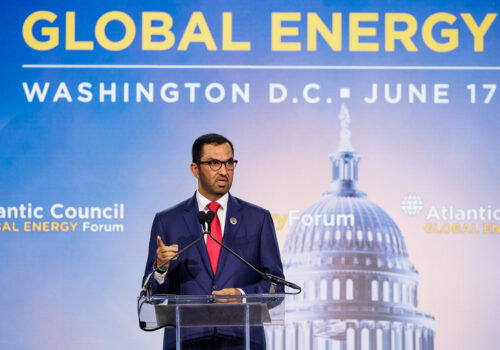Watch the full Global Energy Forum
“An army marches on its stomach.” This famous phrase, often attributed to Napoleon Bonaparte, hits at the importance of logistics and basic supplies in sustaining military deployments. Today, the same can be said of energy.
“The Department of Defense runs on fuel,” said Lieutenant General Jered Helwig, deputy commander of US Transportation Command (USTRANSCOM), on Wednesday at the 2025 Global Energy Forum. “Fuel is a huge part of the equation.”
How huge? On any given day, Helwig said, USTRANSCOM has about two hundred railcars, four hundred aircraft sorties, and fifteen ships moving cargo (including fuel) around the world. In addition, he said, in the past two years USTRANSCOM has taken on the mission of being the global bulk fuel manager for the Department of Defense.
The challenge Helwig faces is not just making sure that the Department of Defense has the necessary amount of fuel, he explained to moderator Meredith Berger, a nonresident senior fellow at the Atlantic Council’s Global Energy Center. It’s also about “getting the right fuel to the right place at the right time, globally,” he explained.
“Anything that moves in the Department of Defense moves in some way through TRANSCOM,” Helwig said.
As if organizing the supply chain to fuel the globally deployed US military were not enough of a task, this very same supply chain makes for a tempting target. In the event of a conflict, Helwig said, “Our adversaries will actively be looking to interdict the supply chains.” This issue of security for not just fuel, but also for electricity, was expanded on in a panel discussion that followed. Here are some highlights of the discussion.
More threats
- “As we are moving fuel around the globe, it’s an incredibly dangerous and expensive thing to do, and the last thing that we want to do is be reliant on a partner, ally, adversary for access to that fuel,” US Deputy Assistant Secretary of Defense for Energy Resilience and Optimization Rebecca Isacowitz said. As a result of this concern, “domestic energy dominance” has been elevated to a “core component of our strategy,” she added.
- The threat extends to domestic electricity and power infrastructure, too, added Alex Fitzsimmons, the director of the Office of Cybersecurity, Energy Security, and Emergency Response at the US Department of Energy. “We know that nation-state actors are prepositioned inside our networks already. They are already inside the wire,” he said. And these adversaries are not just targeting the big US energy companies, which have the resources to resist these attacks. “They’re targeting everyone,” including smaller, regional energy providers.
- Many US military bases abroad were once considered sanctuaries from threats, said Major General Jason Woodworth, commander of Marine Corps Installations Command. Not anymore. “We need to consider them as under threat each and every day,” he said. Some US Marine installations, he explained, are just a few hundred miles from Chinese military bases. As a result, he said, working with private industry to increase resilience in military sites abroad and at home is critical.
More demand
- “The services don’t generate power. We rely on our partners in the commercial industry to do that for us,” said Rear Admiral George Bresnihan, the commander of the Defense Logistics Agency—Energy. What keeps him up at night, he said, is not production as much as how to get energy and fuel to the point of need, when it’s needed.
- And that need is only increasing. Fitzsimmons pointed to artificial intelligence (AI) and onshoring manufacturing as factors in the current surge in energy demand. To win the AI race and be competitive in the twenty-first century, “that’s not possible without energy,” he explained.
- From a private sector perspective, Richard Donaldson, the chief information officer for Duke Energy, agreed that it was an “era of growth” for energy. But the challenge is not just to provide energy for new AI data centers, for example. It’s to provide this power, he said, while also meeting energy demands for other current and future consumers—and to do so in a way that is safe and secure.
More safety and more security
- “One of the most important things we look for in resilience is a backup power generation capability,” said Woodworth. Panelists listed small modular nuclear reactors, microgrids, large-scale backup batteries, and renewable sources of power as important next steps to achieve greater supply-chain resilience.
- New technology is also needed in power grids to make them more efficient and resilient. But as Fitzsimmons warns, “cyber-informed engineering principles” need to be incorporated into the design of new technology so that vulnerabilities to cyberattacks are not inadvertently introduced into the system.
- Nonetheless, cyberattacks will come. “You can solve 90 percent of the cyber problems you face by doing like basic cyber hygiene—multi-factor authentication, network segmentation, things along those lines,” Fitzsimmons says. “But then even if you do all that, you still have to equip them with the training and the planning to operate through compromise.”
John Cookson is the New Atlanticist editor at the Atlantic Council.
Watch the full event
Further reading
Tue, Jun 17, 2025
UAE Minister Sultan Al Jaber on how to solve AI’s energy conundrum
New Atlanticist By Katherine Golden
Meeting the demand for energy associated with AI "is not just a technical challenge,” but a “once-in-a-generation" opportunity, Al Jaber said at the 2025 Global Energy Forum.
Wed, Jun 18, 2025
Senator John Hickenlooper on critical minerals, mining, and the future of clean energy
New Atlanticist By Daniel Hojnacki
Hickenlooper discussed the role of working with allies and making scientific investments in ensuring US energy security.
Wed, Jun 18, 2025
Norwegian Foreign Minister Espen Barth Eide: Ukraine must emerge from war independent—including its energy
New Atlanticist By Katherine Golden
“The geopolitics of energy is important . . . because it is so central to power dynamics," the foreign minister said at the 2025 Global Energy Forum.
Image: A panel discussion at the 2025 Atlantic Council Global Energy Center. June 18, 2025.





